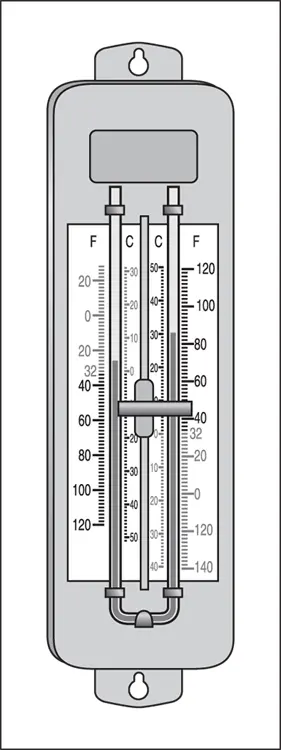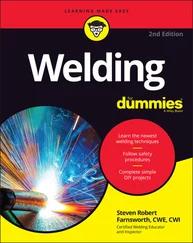Water: Proximity to a pond, stream, wet ditch, or the ocean can make temperature fluctuations less dramatic.
Soil: Different types of soil can create protective or stressful growing conditions. For instance, clay soils hold moisture and heat and thus can reduce stress in dry or very cold conditions. Very sandy soils drain well and are great where excessive water is a problem, but in hot and dry conditions, they can put plants under severe water stress.
Wind: See how strong the winds are and how often you get air movement in a particular area. Winds are very drying.
Temperature: One spot may be significantly hotter or colder than its surroundings. Note that cold air often flows over a landscape like water, settling in low areas and creating cold pockets.A useful tool for determining temperature variation is the maximum-minimum thermometer (also known as a Six’s thermometer). This thermometer can measure the high and low temperature during a given time and can measure the extremes of temperature in a location. See Figure 3-1. This instrument is also available in a digital form. Recording thermometers can store temperatures and humidity levels over longer periods of time, and some can be synchronized to a spreadsheet on your computer. Apps come with some of these digital, remote-sensing devices and can track temperatures on you phone.
Light: Note dramatic differences in amount of daily sun and shade. Human-made structures (yours or a neighbor’s) as well as trees can contribute to these changing conditions.

© John Wiley & Sons, Inc.
FIGURE 3-1:A maximum-minimum thermometer gives you an idea of the outdoor temperature ranges in your area.
Cheating the system: Creating microclimates
Ah, here’s where gardeners can and do cheat their zone ratings so they can successfully grow plants they shouldn’t be able to and satisfy their zone envy. You can actually create microclimates (see the preceding section for general info on microclimates). Usually, the aim is to raise the temperature. For example, you can create a nice Zone 8-ish spot in a colder Zone 7 garden by employing a few gardening tricks:
Safety in numbers: Planting less-hardy plants in groups helps make them more resilient and better able to withstand temperature extremes and drying winds. The local humidity is likely to be higher in a crowd, too.
Mulch: A layer of organically rich mulch moderates soil-temperature fluctuations. It also helps hold in soil moisture so you don’t have to worry about lack of rain or having to water quite as much.
Heat traps: These structures help retain heat. Row covers, hot caps, and cold frames (see Figure 3-2) are well-known ways to trap heat, thus raising the immediate temperature and/or protecting vulnerable plants from cold weather. You can purchase heat traps or build your own. If you want to get fancy, you can add a heating cable to the soil of the cold frame with a thermostat. Then it becomes a hot bed or a miniature greenhouse.© John Wiley & Sons, Inc. FIGURE 3-2:Putting a cold frame to efficient use.
Water: Proximity to water has a moderating effect on temperature, so you may have luck pampering a slightly tender plant by growing it next to a water feature on your property (natural or artificial).
Wind and sun blocks: Fences, walls, buildings, and other structures offer shelter from drying winds and blasts of snow. Warmth and humidity can build up close to them, allowing you to coddle some tender plant. They often also create more shade, which can be cooling or inhibiting, depending on your plant’s needs. You can make a simple inexpensive temporary cold frame with bales of hay, placed in a rectangle and covered with a glass window or door sash.
Bending the rules to stretch your growing season
Maybe it’s the rebel in you, me, and all gardeners. Maybe it’s natural restlessness. Maybe it’s an urge to make maximum and efficient use of available time. But gardeners do like to try to push the envelope in order to grow more or better or different plants.
You can dig up many tricks and techniques along these lines, and you certainly may come up with a few of your own as your experience grows. The following sections describe some favorite rule-benders that you can try if appropriate to your garden, your needs, and your climate.
Incorporating warming tricks
If frost will damage a plant, perhaps you can still have it outdoors by shielding it somehow. This idea applies both to setting plants out a bit too early in the spring and leaving them in the garden a bit too late in the fall.
Use row covers, blankets, water walls (heavy pieces of plastic that have sections filled with water that holds heat) burlap, plastic sheeting, or extra mulch (compost, weed-free hay, pine straw, which is actually pine needles), or pine boughs. Water well; hydrated roots can withstand cold and drought better.
You may find you tried to stretch the growing season a little too far, or perhaps the weather experts missed the mark on the date of the final frost. A big chill is creeping up, and you’ve already used mulch and blankets as much as you can to keep the plants warm. What’s a gardener to do? Try a little emergency frost protection.
Spray vulnerable plants with water to slow or prevent plant injury caused by chilling (as Florida orange growers know all too well when a rare frost threatens). How does this work? Cold, dry air tends to draw the moisture out of leaves and from the ground; the spray of water raises the humidity levels, which in turn reduces moisture loss. Also, in order for water vapor to condense or for water to freeze, the water has to release heat, which in turn warms the plant. The plants need to be kept wet until the danger of freezing has passed; using a sprinkler system is the most practical way.
Bringing the plants inside
Potted plants, provided they’re not too big or heavy, may be pretty easy to move indoors for a time. Most plants tend to grow less and be less productive or unproductive during the winter months, so you also want to reduce water and plant food. You may even cut the plants back and just keep the pots moist enough to keep the roots alive until spring returns.
Prized plants or special herbs that you want to save can also come inside when you dig them up out of the garden and put them in a pot. Again, they may not grow full force, but you can try to keep them alive. They may experience cooler temperatures inside but not the hard frost that would damage or kill them outdoors. If you plan to enjoy these plants longer, give them a warm and sunny spot on a windowsill or insulated sunroom. Water and feed moderately, and keep an eye out for pests.
To save space, you may want to cut these plants and root them indoors before planting them outside in warmer weather. See Chapter 10for more information.
 By the way, dried herbs, canned vegetables, carefully stored (and cured, where applicable) fruits and vegetables all keep the bounty and memory of the garden alive in the off-season. So do dried bouquets and potpourris.
By the way, dried herbs, canned vegetables, carefully stored (and cured, where applicable) fruits and vegetables all keep the bounty and memory of the garden alive in the off-season. So do dried bouquets and potpourris.
Конец ознакомительного фрагмента.
Текст предоставлен ООО «ЛитРес».
Прочитайте эту книгу целиком, купив полную легальную версию на ЛитРес.
Читать дальше


 By the way, dried herbs, canned vegetables, carefully stored (and cured, where applicable) fruits and vegetables all keep the bounty and memory of the garden alive in the off-season. So do dried bouquets and potpourris.
By the way, dried herbs, canned vegetables, carefully stored (and cured, where applicable) fruits and vegetables all keep the bounty and memory of the garden alive in the off-season. So do dried bouquets and potpourris.










